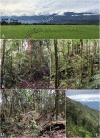Elevational surveys of Sulawesi herpetofauna 1: Gunung Galang, Gunung Dako Nature Reserve
- PMID: 37637176
- PMCID: PMC10448876
- DOI: 10.7717/peerj.15766
Elevational surveys of Sulawesi herpetofauna 1: Gunung Galang, Gunung Dako Nature Reserve
Abstract
The Indonesian island of Sulawesi has a unique geology and geography, which have produced an astoundingly diverse and endemic flora and fauna and a fascinating biogeographic history. Much biodiversity research has focused on the regional endemism in the island's Central Core and on its four peninsulas, but the biodiversity of the island's many upland regions is still poorly understood for most taxa, including amphibians and reptiles. Here, we report the first of several planned full-mountain checklists from a series of herpetological surveys of Sulawesi's mountains conducted by our team. In more than 3 weeks of work on Gunung Galang, a 2,254 m peak west of the city of Tolitoli, Sulawesi Tengah Province, on Sulawesi's Northern Peninsula, we recovered nearly fifty species of reptiles and amphibians, more than a dozen of which are either new to science or known but undescribed. The incompleteness of our sampling suggests that many more species remain to be discovered on and around this mountain.
Keywords: Altitudinal gradient; Biodiversity; Biodiversity survey; Herpetology; Reptiles and amphibians; Southeast Asia; Transect survey; Wallacea.
© 2023 Karin et al.
Conflict of interest statement
The authors declare that they have no competing interests.
Figures




References
-
- Advokaat EL, Hall R, White LT, Watkinson IM, Rudyawan A, BouDagher-Fadel MK. Miocene to recent extension in NW Sulawesi, Indonesia. Journal of Asian Earth Sciences. 2017;147(2):378–401. doi: 10.1016/j.jseaes.2017.07.023. - DOI
-
- Cannon CH, Summers M, Harting JR, Kessler PJA. Developing conservation priorities based on forest type, condition, and threats in a poorly known ecoregion: Sulawesi, Indonesia. Biotropica. 2007;39(6):747–759. doi: 10.1111/j.1744-7429.2007.00323.x. - DOI
-
- Frantz LAF, Rudzinski A, Nugraha AMS, Evin A, Burton J, Hulme-Beaman A, Linderholm A, Barnett R, Vega R, Irving-Pease EK, Haile J, Allen R, Leus K, Shephard J, Hillyer M, Gillemot S, van den Hurk J, Ogle S, Atofanei C, Thomas MG, Johansson F, Mustari AH, Williams J, Mohamad K, Damayanti CS, Wiryadi ID, Obbles D, Mona S, Day H, Yasin M, Meker S, McGuire JA, Evans BJ, von Rintelen T, Ho SYW, Searle JB, Kitchener AC, Macdonald AA, Shaw DJ, Hall R, Galbusera P, Larson G. Synchronous diversification of Sulawesi’s iconic artiodactyls driven by recent geological events. Proceedings of the Royal Society B: Biological Sciences. 2018;285(1876):20172566. doi: 10.1098/rspb.2017.2566. - DOI - PMC - PubMed

